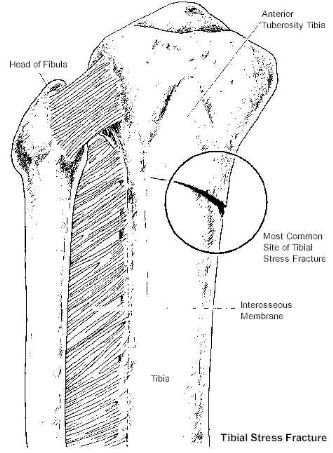
Tibial Stress Fractures (shin splints)
Synopsis
A tibial stress fracture, a small crack of the lower leg bone, occurs when a bone is subject to pounding over a short period of time. Stress fractures occur two to three weeks into the training season. They occur when you come off a relatively inactive period and start going quickly into heavy training.
The most common place for a stress fracture to develop is at a junction on the top one-third and the middle one-third of the tibia, where the architecture of the bone changes quite suddenly. One part of the bone is funnel-shaped and the other is cylindrical. The difference leads to increased stress concentration and this is where stress fractures develop.

Diagnosis and Treatment
At first, the pain from the stress fracture will be dull and aching; the discomfort will be centered in one spot on the lower leg bone. Pain in other forms of shin splints is diffuse. Initially, you will be able to run through the pain. But each time you do, your leg will become more painful. Finally, the pain becomes so severe that running is impossible. At this point, you usually check with your doctor.
The physical examination will show extreme tenderness at the exact location of the stress fracture. The maximum area that hurts is no more than one inch. This is much smaller than the area of tenderness that comes from having tibial periostitis, posterior tibial shin splints, or the anterior compartment syndrome.
X-rays are generally always taken. But, if they are taken within the first week of the onset of pain, they will often be negative. Given enough time, however, new healing bone will appear on the x-rays. A bone scan will show a “hot spot” a lot sooner than X-rays will see bone healing. This test isn’t always used, especially if rest and activity modification are reducing symptoms.
Patients are usually asked to take a cutback in their activity level for a period of time. Rest is the only cure. Icing, taping, or a cast are not necessary, but sometimes enhance comfort as the pain subsides. Foot orthotics may also be prescribed to help better the alignment as a preventative measure. It requires four to six weeks of rest for complete healing to take place. Gradually reestablish the conditioning in your legs. It usually takes three weeks to return to full sports activities. It is highly uncommon that a tibial stress fracture comes apart or becomes displaced. That is why a cast is not necessary. Once healed, it is unusual for this to happen again.